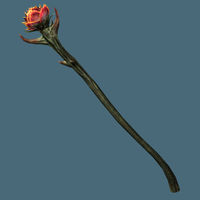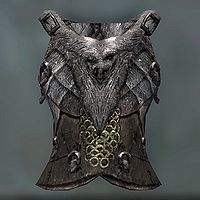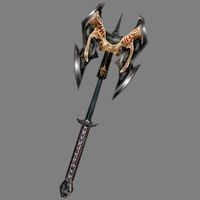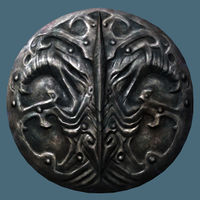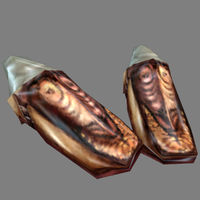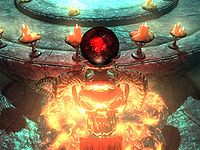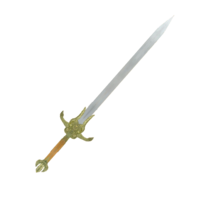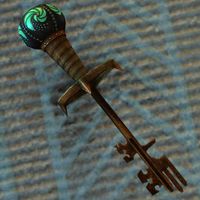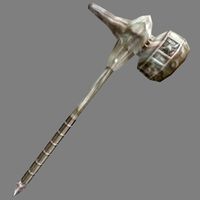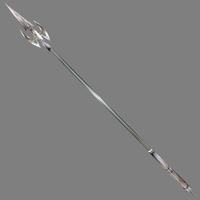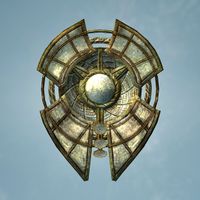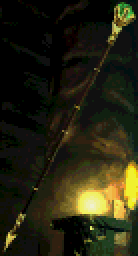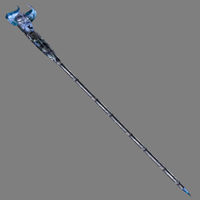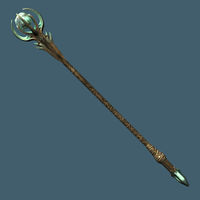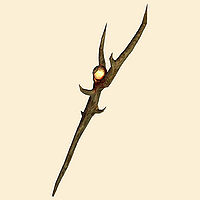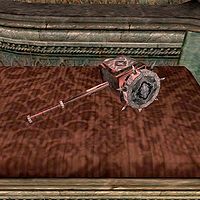Lore:Artifacts S
Sanguine Rose
The Sanguine Rose (sometimes called Sanguine's Rose) is a Daedric artifact created by the Daedric Prince Sanguine. It can take on many forms, including that of an actual rose, a wooden stave carved like a rose or a staff-sized rose. Although powerful, the Rose is not an artifact most would care to possess. It can be used to summon a lesser Daedra, who will attack all except the holder. The Daedra is uncontrollable, unlike those summoned by Conjuration, but as with conjured creatures it is only bound to the mortal plane temporarily. Each time the Rose is used it wilts a little, and when all the petals fall off, it loses its power. When this happens, a new rose blooms somewhere in Oblivion and is plucked by Sanguine to be given to another champion.For more information see the main Lore article.
Found in:
Savior's Hide
Savior's Hide, also known as Scourge of the Oathbreaker, is a Daedric artifact commonly associated with Hircine. The name Savior's Hide is usually associated with just the cuirass, but a full set of the hide once existed (boots, cuirass, gauntlets, greaves, helmet, and pauldrons), though the rest of the items have not been seen since 3E 399. The cuirass makes the wearer resistant to magic.
There are two creation stories to the Hide, the widely known one crediting Hircine and the lesser known one crediting Malacath. Of the two stories the one involving Hircine has more truth, as the story crediting Malacath claims that the armor as a whole makes the wearer vulnerable to magic and invulnerable to the blow of an oathbreaker. It agrees on the point that the Hide would protect the wearer from the sting of the Spear of Bitter Mercy. The more widely known legend holds that Hircine rewarded the first and only mortal to escape his Hunting Grounds with his peeled Hide. The mortal then had the Hide tailored into the cuirass for use in their adventures. This version also holds that the cuirass has a special ability to resist magic.
For more information see the main Lore article.
Found in:
Scourge
Flagelo (também conhecido como Martelo de Mackkan, Perdição de Daedra, o Flagelo Daédrico ou Flagelo, Abençoado de Malacath) é um lendário artefato Daédrico. Forjado em ébano sagrado nos Fogos (ou Fontes) de Fickledire, e é associado a Malacath. É uma arma feroz e assume a forma de uma maça de aço ou ébano. Malacath dedicou isso aos mortais e a qualquer Daedra que tente invocar seu poder, sendo banido ao Vazio. Também tem a habilidade de bani-los ao Vazio com um único golpe, assim como pode conjurar Daedra como os Dremora e Scamps de Oblivion para fazer o que portador desejar. Foi descrita como "defensor corajoso do desamparado", que pode estar relacionado ao papel de Malacath como Príncipe Daédrico dos exilados.
Flagelo foi usado uma vez por Mackkan, que baniu muitos dos lacaios de Mehrunes Dagon com ele. A maça eventualmente ficou em posse do Terceiro Império e foi pendurada no arsenal de Battlespire. A Legião das Sombras a usou contra Lordes Daedra em nome do Imperador. No rescaldo da invasão de Dagon ao Battlespire durante o Simulacro Imperial, a maça escondida foi recuperada da seção Caitiff do Battlespire por um aprendiz de Mago de Batalha e usado para ajudar a retrair as forças Daedra. Um Daedra chamado Vonshala Keriayn estava interessado em obter a maça em troca de um pedaço da guia vazia do Battlespire, mas ela foi banida depois de tentar empunhá-la. Flagelo sobreviveu a destruição de Battlespire e retornou a Tamriel. Agora vaga pela terra com aventureiros. A maça esteve em posse de Divayth Fyr, que a manteve em Tel Fyr, uma torre Telvanni em Morrowind, na Baía Zafirbel. O Nerevarine supostamente liberou a arma da coleção de Fyr em 3E 427.
Found in:
Shield of Ysgramor
The Shield of Ysgramor was buried within the tomb of that famous hero of the Nords in the Late Merethic Era. It's unknown if Ysgramor ever wielded this shield in battle; legend only mentions his use of the axe Wuuthrad. In 4E 201, it was found by members of the Companions within the tomb. The wielder of the shield is both harder to kill and resistant to magic.
Found in:
Shoes of St. Rilms
The Shoes of St. Rilms the Barefooted are artifacts sacred to the Dunmer. They make the wearer more fit and personable. The eponymous saint gave away the shoes and did her best to appear as a beggar in order to better acquaint herself with the poor. In 3E 427, the Nerevarine was sent by the Tribunal Temple to retrieve the shoes from an ancient Chimeri ruin, and later received the shirt as a reward for various services to the Temple.
Found in:
Sigil Stone
A Sigil Stone is a pre-Mythic quasi-crystalline morpholith that has been transformed into an extra-dimensional artifact through the arcane inscription of a daedric sigil, which can be used to create portals from Mundus to Oblivion. They are spherical objects, and emit both a humming noise and a dark red glow. The morpholiths used to create the Sigil Stone can only occur in pocket voids of Oblivion, and harvesting them requires Daedric assistance. The cleansed morpholith must then be presented to a Daedra Lord to perform the inscription of the sigil, which will transform the specimen into a true Sigil Stone. The Daedra Lord and the mechanic of the Sigil Stone must then jointly invoke the conjurational charter, which will transport the Stone through the liminal barrier and create a temporary portal. The portal only remains open for a brief period of time, depending on the strength of the liminal barrier at the chosen location; the longest recorded time under these circumstances were only a few minutes, making these type of portals rather useless. The power of a Sigil Stone is similar to that of a filled soul gem, but much stronger. Many ready-made sigil stones can be found in Oblivion, and can be obtained by powerful conjurers who force an unbound Daedra into submission. Dremora are often used for this purpose, although their Lord Mehrunes Dagon is angered by this theft.
During the Oblivion Crisis, the loss of the Dragonfires caused the liminal barrier to slowly weaken and allowed these liminal bridges to remain open indefinitely. This was exploited by the Mythic Dawn and Mehrunes Dagon, who created "Oblivion Gates" to the Deadlands, allowing the Daedric forces to invade Tamriel. A method of destroying these Gates was discovered by the Champion of Cyrodiil at the Sack of Kvatch: removing the Sigil Stones from the well-defended keeps in the Deadlands where they were hidden would break the connection, teleporting those near the Stone back to Mundus and destroying both the Oblivion Gate and its Sigil Keep in the process. Occasionally, Gates would have multiple Sigil Stones supporting the link, and all of them would need to be removed to shut the Gate; similarly, one Sigil Stone may support multiple Gates. This technique for opening portals was exploited at the Battle of Bruma by the united forces of Cyrodiil (led by Martin Septim) to procure a Great Sigil Stone, a more powerful specimen used to sustain larger portals such as the "Great Gates". Each Oblivion Gate which was opened weakened the liminal barrier, eventually completely diminishing it and allowing Mehrunes Dagon pass fully into Mundus. The barriers were restored when the Amulet of Kings was smashed, summoning the power of Akatosh to banish Dagon.
Sigil Stones have other uses apart from sustaining liminal bridges. One was used as an opposing force to a Great Welkynd Stone to open a portal to Gaiar Alata. Daedric Siege Crawlers use them as a power source. The arcane power of a Stone can be used in enchanting, consuming the Stone in the process. Powerful conjurers require Sigil Stones for use in rituals to summon items and Daedra from Oblivion when using an Atronach Forge, although the Stone isn't necessary when summoning lesser objects. Sigil Stones can also be used to create less permanent portals to Oblivion, which can be opened at will as long as the Stone remained intact, although this method binds the stone to a particular location in Mundus.
Found in:
Sinweaver
Sinweaver is an artifact once wielded by Azani Blackheart, a Redguard outlaw and an avid scholar of the Ayleids. It is an Elven claymore, possibly of Ayleid origin. Its enchantment inflicts magical fire damage and drains the stamina of those that it strikes.
Circa 3E 433, a wizard named Argoth employed the Fighters Guild to invade Blackheart's base, the Ayleid ruin of Arpenia, and recover Sinweaver. A large group of warriors were sent to the ruins, but were successfully repelled by Blackheart. Fifteen guild members died, including the son of Guildmaster Vilena Donton, and many more were injured. Argoth turned to the Blackwood Company to complete the job. However, the Company double-crossed Argoth and seemingly made a deal with Blackheart: if he gave them Sinweaver and departed from Arpenia, the Blackwood Company would pay him off and reveal Argoth's location. Blackheart agreed, and subsequently killed the wizard, retrieving his weapon. He then moved his base to Atatar, another Ayleid ruin not far from Arpenia.
Seeking to defame the rival Blackwood Company, Fighters Guild second-in-command Modryn Oreyn, along with a new recruit, investigated the abandoned ruins of Arpenia. Oreyn's suspicions proved correct when he found the place free from any signs of battle. The two then journeyed to nearby Atatar, which was being guarded by Blackheart's bandit allies. After fighting their way into the depths of the ruins, Oreyn and the recruit confronted Blackheart and killed him, avenging their fallen comrades. Oreyn took Azani's ring as proof that the Blackwood Company had not completed their contract, and Sinweaver was taken by the recruit.
Found in:
Skeleton Key
The Skeleton Key (also called the Skeleton's Key) is a Daedric artifact created by the Daedric Prince Nocturnal. In appearance it doesn't always take the form of a key, and sometimes manifests as a lockpick instead. In its key form, it can be used to unlock any lock. As a lockpick, it is nigh unbreakable and can get past even the toughest locks. The two limitations placed on the Key by wizards who sought to protect their storehouses were that the Key could only be used once a day and it would never be the property of one thief for too long, eventually disappearing. The artifact functions as a tool for "unlocking" all things, including portals, hidden potential, and other unknown possibilities. Its ultimate function, however, is to unlock and hold open the Ebonmere, a portal to Nocturnal's realm, Evergloam, located in the Twilight Sepulcher of Skyrim. The Nightingales are tasked with guarding the Sepulcher and retrieving the Key should it be stolen. Unfortunately, the Prince is said to allow the Skeleton Key to be stolen or lost periodically, whether by purpose or apathy.
The first supposed wielder of the Key was the thief Arrovan. After disappearing, the Key always chose inaccessible places to hide, and for the benefit of historians Arrovan made a list of the various resting places. The Skeleton Key was uncovered during the Imperial Simulacrum by the Eternal Champion in either Valenwood or Summerset Isles (reports vary) while following rumors of the Key having appeared in one of the known dungeons. In the events leading up to the Warp in the West, an unknown agent of the Blades was tasked by Nocturnal to kill a mage in his stronghold. The agent was then gifted the Key by a worshipper of the Prince. The Key later came into the possession of Gentleman Jim Stacey, leader of the Thieves Guild in Vvardenfell. The Key was passed on to the Nerevarine in 3E 427, although how Stacey came to lose it is unclear: some say it was in return for killing Sjoring Hard-Heart, the Master of the Vivec City Fighters Guild, while others say the Nerevarine took it by force.
Circa 3E 433, an artifact known as the Eye of Nocturnal was stolen from Nocturnal's shrine in Cyrodiil's Blackwood region. Nocturnal tasked the Champion of Cyrodiil with recovering it. The thieves, an Argonian couple in Leyawiin, hid it in a flooded cave in Topal Bay. The Champion returned it to Nocturnal and was rewarded with the Skeleton Key.
Some time before 4E 201, the Key was stolen from the Twilight Sepulcher by Mercer Frey, a corrupt Nightingale. Its long-term loss resulted in a decline of the Skyrim branch of the Thieves Guild due to bad luck without Nocturnal's influence. The guild's influence declined until their only presence was in the Ratways beneath Riften. Mercer used the Key to bring himself luck, but he was eventually confronted by the Nightingales beneath the Great Statue of Irkngthand. Mercer was killed, and the Last Dragonborn brought the Key back to the Sepulcher, reopening the Ebonmere.
Found in:
Skull Crusher
The Skull Crusher is an amazingly large and powerful weapon. The warhammer was created in a fire magically fueled by the wizard Dorach Gusal and then forged by the great weaponsmith Hilbongard Rolamus. The steel is magically hardened and the weight of the weapon is amazingly light, which makes for more powerful swings and deadly blows. It was to be put on display for a festival, but thieves got it first. It is said the weapon still travels Tamriel in search of its creators. The Nerevarine reportedly recovered the warhammer and sold it to the Mournhold Museum of Artifacts in 3E 427.
Found in:
Skull of Corruption
The Skull of Corruption is Vaermina's signature artifact. It is an incredible staff that creates a duplicate, or "clone", of whomever it is cast upon. This clone then attacks the original at the behest of the caster. Legends say that the staff has a mind of its own, and can feed on the memories of those around it.
Found in:
Soul Sword
The Soul Sword is a shimmering longsword imbued with the soul of Prince A'tor following his death in 2E 864. Aside from being a powerful weapon, the sword can move of its own accord and allows A'tor's spirit to communicate with the wielder.
During the Battle of Hunding Bay off the coast of Stros M'Kai, A'tor was hit with a poison arrow by the Dunmer assassin Dram, allegedly using the Bow of Shadows. Arch-Mage Voa attempted to heal him, but instead was only able to trap his soul in a soul gem and preserve his body under a stasis field before the dragon Nafaalilargus killed everyone onboard the ship.
A'tor's surviving supported formed a rebel group named the Restless League on Stros M'Kai following the ensuing Imperial occupation. The League planned to resurrect A'tor, whose body was being hidden in the temple of Arkay in Port Hunding. Iszara, a member of the League who was close to the prince, grew frustrated with the League's lack of action and attempted to go through with the resurrection herself. She made contact with the Sload necromancer N'Gasta, who promptly betrayed her, stealing the soul gem and selling Iszara's soul to Clavicus Vile.
Seeking to curry favor with the island's new ruler, Provisional Governor Amiel Richton, N'Gasta had A'tor's soul gem delivered to the palace, ironically by Iszara's brother Cyrus. It was then placed in the palace vaults, to be guarded by Nafaalilargus. Cyrus later rescued Iszara from her fate and killed the dragon to retrieve the soul gem for the rebels. With the help of a Yokudan witch named Saban, the League then attempted to resurrect A'tor. Instead, his soul entered the sword he was buried with, seemingly as a symbol of his intention to take up arms against the Imperials. Cyrus took up the sword and gave a speech to the disheartened rebels, inspiring them to capture the port while Cyrus went after Governor Richton.
Through the sword, A'tor opened a secret entrance into the palace. Cyrus fought his way to Richton, who was attempting to escape on a Dwemer airship. Cyrus disarmed Richton, but was outsmarted and forced to surrender when Dram came up behind him. After dropping the sword however, Cyrus revealed that A'tor had not truly been killed, prompting the sword to slay both Richton and Dram of its own accord and allowing Cyrus to escape.
Following the successful rebellion, the Soul Sword was given to Iszara. Through it, A'tor advised her to open dialogue with Emperor Tiber Septim, which led to the signing of the First Treaty of Stros M'Kai. She subsequently remained on Stros M'Kai as ruler.
Found in:
Spear of Bitter Mercy
The Spear of Bitter Mercy is one of the more mysterious artifacts in Tamrielic lore. Little to nothing is known about the Spear, but it is believed to be of Daedric origin.
According to Reachmen myth, the Daedric Prince Hircine was said to wield the Spear when he took on the aspect of Alrabeg the Hunter. Other legends speak of a Nord hunter named Thane Icehammer, who unknowingly killed several were-creatures while on a hunt. Angered by this, Hircine thrust the Spear into Icehammer's side, where upon the tip broke off and remained lodged inside him. Slowly, the magic of Hircine's Spear corrupted Icehammer's mind and he became bitter and angry. This eventually resulted in him murdering an acolyte of Kyne in a fit of rage, and fleeing to an ancient burial vault near Cragwallow, where upon he was sealed within as punishment.
Over time, the Spear resurfaced and according to some legends it was used by a mighty hero during the fall of the Battlespire. The hero was aided by the Spear in the defeat of Mehrunes Dagon and the recapturing of the Battlespire. Since that time, the Spear of Bitter Mercy has made few appearances within Tamriel. It was last reported to be in the hands of the Nerevarine, who received it as a reward from Sheogorath in 3E 427. The Nerevarine sold it to Torasa Aram, who put it on display in the Mournhold Museum of Artifacts.
Found in:
Spellbreaker
The Spellbreaker (also spelled Spell Breaker) is an artifact attributed to the Daedric Prince Peryite. Superficially a Dwarven tower shield, it is one of the most ancient relics in Tamriel. The shield not only protects its wielder from physical damage, but also from magical attacks, by reflecting magicks, dispelling curses, or silencing any mage about to cast a spell. It is said that the shield still searches for its original owner, and will not remain the property of anyone else for long.
It played an important role in the historic Battle of Rourken-Shalidor. The shield was uncovered by the Eternal Champion during the Imperial Simulacrum, in either Hammerfell or Valenwood (reports vary). In the events leading up to the Warp in the West, an agent of the Blades contacted Peryite in search of power. The agent reminded the Prince of a mortal from the First Era, and Peryite took a shine to the agent. He had the agent slay a Vampire Ancient who had displeased him, and in return he had one of his worshippers give the Spellbreaker to the agent.
Mastrius, a Dunmer vampire who had been imprisoned for centuries in the Salvel Ancestral Tomb near the Red Mountain of Vvardenfell by Azura, required the Spellbreaker to break the curse keeping him in his prison. In 3E 427, the weakened Mastrius was discovered by a fellow vampire who agreed to help free him. The Spellbreaker was found in the Dwemer ruin of Bthuand, near the skeleton of its previous owner who had died in a cave-in. Mastrius used the shield as a conduit for his spell and broke Azura's curse, returning to full strength. He then betrayed his fellow vampire and was slain; his accomplice then claimed the Spellbreaker. Later that year, the shield came into the possession of Torasa Aram and was put on display in her museum of artifacts in Mournhold.
In 3E 433, worshippers of Peryite in Cyrodiil attempted to become closer to the Prince by performing a risky ritual which resulted in trapping their souls in Peryite's realm of Oblivion, the Pits. The Champion of Cyrodiil found the frozen bodies of the worshippers around Peryite's shrine by the Silverfish River. The Prince spoke with the Champion, and requested that they enter Oblivion and retrieve his worshippers' souls. The Champion obliged, and was rewarded with the Spellbreaker.
In 4E 201, the Last Dragonborn summoned Peryite and was tasked with killing the Bosmer Orchendor, a monk of Peryite who had rebelled against the Prince. He dwelled in the Dwemer ruin of Bthardamz in Skyrim, along with many Bretons from High Rock who had been cursed by Peryite with a terrible plague. The Dragonborn infiltrated the ruins, killing the afflicted Bretons before defeating Orchendor and sending his soul to the Pits. Peryite rewarded the Dragonborn with the Spellbreaker.
Found in:
Staff of Chaos
The Staff of Chaos (sometimes called the Staff of Unity and Chaos) is an ancient relic of untold power. The staff, also called Balac-thurm, was created by Loreth, a pupil of the hermetic enchanter Dalak. Loreth created the ebony staff, sometime after 1E 480, based on his own findings and skills. Having been forged from the essence of the very Land itself, it is nigh-indestructible. It has the power to open gateways into other worlds and is capable of obliterating the entire corporeal form of a living creature.
The staff played a central role in the Imperial Simulacrum. In 3E 389, the Imperial Battlemage to Uriel Septim VII, Jagar Tharn, who had stolen the staff from beneath the city of Mournhold, used it to imprison the Emperor and General Warhaft in the realm of Oblivion. He then used it to destroy his apprentice, Ria Silmane in order to prevent the Elder Council from learning of his betrayal.
To solidify his grasp over Tamriel and ensure nobody had a chance to rescue the true Emperor, Tharn knew he had to dispose of the staff. Unable to destroy it, he did the next best thing, splitting it into eight fragments and hiding each piece within the most forgotten and dangerous places throughout the provinces.
In the event the staff were reacquired, Tharn planned ahead. He drained the staff of all its magical potential, placing it within the Jewel of Fire underneath the Imperial Palace. If one were to relocate the staff and reassemble it, they would find it to be utterly useless.
When the Eternal Champion reunited the eight pieces of the staff and linked it to the Jewel of Fire, the combined energies of Tharn's lifeforce and the Staff of Chaos were released in a powerful surge of energy, culminating in the destruction of both the Battlemage and the Staff itself. The release of energy opened a gate to free Uriel Septim VII and Warhaft from their otherworldly prison, and destroyed much of the Palace interior.
Found in:
Staff of Hasedoki
The Staff of Hasedoki belonged to the wizard Hasedoki, who was, to the best of all knowledge, the greatest wizard of his time. It is said that he felt so lonely and isolated because so many feared his power, that he bonded his soul into his very own staff, where it remains. Magic users all over Tamriel have been searching for it ever since to benefit from its magical protection. The Nerevarine reportedly recovered the staff and sold it to the Mournhold Museum of Artifacts in 3E 427.
Found in:
Staff of Magnus
The Staff of Magnus is one of the elder artifacts of Tamriel. It was created by Arch-Mage Magnus, the God of Magic who served Lorkhan in designing Mundus. It served Magnus as a metaphysical battery, but remained behind when the god fled Mundus in the Dawn Era. Since then, it has served mortals. Some believe it was a gift, others say it was stolen, and others believe it to be a test. In appearance it is a metallic staff, sometimes made of Daedric Ebony, often with a sphere at the end of it. It has the ability to suppress magic, protect its bearer from magical attacks, restore the bearer's health, or allow the bearer to absorb spells. It can also be used offensively as a blunt weapon, and to absorb an enemy's magicka, and eventually their life force. In time, the staff will abandon its owner before he becomes too powerful and upsets the mystical balance it is sworn to protect. The staff can be used to manipulate the Eye of Magnus, although their true relationship is unknown.
By 2E 582, the staff had come into the possession of the Aldmeri Dominion. It was brought to a secure vault in the newly-built city of Marbruk in Greenshade for safekeeping. However, it was then stolen by Vicereeve Pelidil for the Veiled Heritance, who had resurrected the recently deceased Prince Naemon as a lich. Naemon's shade took the staff to Hectahame, an Ayleid ruin where the Heart of Valenwood was kept, and began the process of using the staff to corrupt the Heart. He also used it to subdue ancient wards protecting the ruins from necromancy, which had been put in place long ago after a failed attempt to raise an army of undead there. The Heritance hoped to kill the entire Valenwood by corrupting the Heart, turning it into an evil realm known as Shadow Wood. However, the Dominion were successful in infiltrating the ruins and killing the lich-lord, and the staff was returned to Queen Ayrenn.
The staff was uncovered by the Eternal Champion during the Imperial Simulacrum in either Elsweyr or Valenwood (accounts vary). Some time in the Third Era, the staff was taken from a wizard by the Mages Guild. In death, the wizard's spirit remained bound to Nirn, until one of his descendants sent an adventurer to recover the staff from the Mages Guild. A fake copy of the staff also appeared in the Iliac Bay region before the events of the Warp in the West; it was created by a mage in an attempt to bribe an agent of Nocturnal who has been sent to assassinate him. The fake staff functioned identically to the true artifact, but after several days it crumbled to dust.
By 3E 427, the staff had come into the possession of Dreveni Hlaren, a Dunmer sorceress and summoner. She lived in Assu, a cave on the slopes of Mount Kand, on the island of Vvardenfell. The Mages Guild learned of the artifact's location, and the Nerevarine was sent to slay Dreveni and claim the staff. Later that year, the Nerevarine sold the staff to Torasa Aram, who put it on display in her Museum of Artifacts in Mournhold.
In the Fourth Era, the staff appeared in the possession of an undead Dragon Priest named Morokei, who had, relatively recently, awoken from his ancient slumber. Morokei was entombed in the Labyrinthian, which was once the ancient Nord city of Bromjunaar, the capital of the Dragon Cult. A group of mages from the College of Winterhold journeyed to Labyrinthian to recover the staff, but only Savos Aren survived the ordeal. Aren sacrificed two of his companions to trap Morokei, and sealed the main entrance to the ruins. In 4E 201, the Synod came to Skyrim in search of artifacts, and attempted to use the Dwemer Oculory in Mzulft to detect magical power. With the aid of a member of the College of Winterhold, a Synod researcher used the Oculory to find the location of the Staff of Magnus, but all other readings were blocked out by the Eye of Magnus which was currently being tampered with in the College. The College member entered Labyrinthian and defeated Morokei. The staff was then used by the College to control the Eye of Magnus until the Psijic Order removed the Eye from Mundus.
Found in:
Staff of Sheogorath
The Staff of Sheogorath, a powerful Daedric artifact, is the symbol of the Daedric Prince of Madness. It contains the power of the Shivering Isles, and is needed to assume the title of Mad God and sit upon the Throne of Madness. The Staff is the namesake of Sheogorath. In its traditional appearance, the Staff is a simple walking stick, often with an eyeball attached to the top. During each Greymarch, the Staff's power waned and it became a useless twig. This marked the beginning of Sheogorath's transformation into Jyggalag.
Found in:
Staff of Towers
The Staff of Towers is an artifact crafted by the Ayleid arch-mage Anumaril around the time of the Alessian Slave Rebellion. It is composed of eight segments, each corresponding to one of the metaphysical Towers that shape the fabric of Nirn. No sooner was the Staff constructed than it was separated into eight pieces, seven of which were taken to far corners of Tamriel and hidden by White-Gold Knights. The eighth, made in the image of White-Gold, Anumaril himself wore as a femur while walking with other Ayleid refugees to Valenwood and the Tower of Green-Sap. There, he located the Stone of the Tower, the Perchance Acorn, and built an orrery around it, attempting to convert Green-Sap into another White-Gold to restore the Ayleid empire. This attempt failed, due to a fundamental incompatibility between Ayleid and Bosmer magic and belief.
Centuries later, Arch-Prelate Fervidius Tharn of the Alessian Order dispatched agents to recover all eight pieces and reassemble the Staff. It was then used by the radical Marukhati Selective in an attempt to excise the Aldmeri influences from the Dragon God of Time, Akatosh. The wild ritual resulted in a massive Dragon Break, and once again disintegrated the Staff into eight pieces. The pieces slowly fell back to Tamriel as stars, and were the only means for those trapped in the Middle Dawn to chart the progress of time. It is unknown what became of the fragments after they finally fell to the ground.
Star Teeth
The Star Teeth are magical prismatic crystals taken from the skies by Ayleid Airships during the Merethic Era. Seven Star Teeth were captured by the Airships.
The crews of the Airships believed them to be fire gods from the night sky. The Teeth were artifacts of light, in some way associated with the stars; the Ayleids believed starlight to be the purest form of the element. The Star Teeth had the ability to counteract powerful Shadow Magic. The descent of the Star Teeth matches the description of "shooting stars", Aetherial Fragments falling to Nirn from Aetherius; this would imply that they are made of Meteoric Glass. The Star Teeth appear structurally similar to Welkynd Stones, but without the capability to store magicka. Although apparently impossible to control, the Teeth emit sporadic bursts of light. The true nature of their light magic remains unknown, but their potency is seemingly lessened by shade or darkness.
The seven Star Teeth were traditionally held in the Vault of the Heavens in the Agea Relle, later known as the Crypt of Hearts. Placed on the pedestals there, they provided a powerful magical enhancement which could be used to fight creatures of shadow. The Ayleids later abandoned the Agea Relle, and in the early Second Era a school for adventurers was established in the ruins by two Altmer, Nerien'eth and Alanwe. Alanwe discovered the crystals on their pedestals, and named them Star Teeth due to their similarity to a row of teeth. After researching the Teeth, she attempted to weaponize their light by emulating their enchantment with a Welkynd Stone as a base. She hoped that their light magic could be used against Daedra and all manner of undead, or at least as reusable torches or paperweights should her experiments prove unsuccessful. Alanwe's plans were never realised, as her husband Nerien'eth fell under the influence of Mephala and killed her after claiming the Ebony Blade.
The haunted Agea Relle became known as the Crypt of Hearts, and was avoided by the people of Rivenspire for many years. The ruins were eventually cleared of undead and Daedric influence in 2E 582, at which point shards of the Star Teeth had begun to be circulated throughout Tamriel.
In time, the Star Teeth left the vault and were scattered across Tamriel. By 3E 397, only five were known of, the other two having faded from memory. During the War of the Bend'r-mahk, the shadowmage Skelos Undriel tasked an unknown hero, the Soul of Conflict, with retrieving the five known Star Teeth, which he needed to fight the Umbra' Keth, a Shadow of Conflict created by the ongoing war. The Star Teeth had come into the possession of several influential figures in the area:
- The Witch Tree, a sentient tree located in Ghast's Pass in Hammerfell, had grown around a Star Tooth
- Porliss Caith, an Argonian agent of Hammerfell in the ongoing war
- Tanyin Aldwyr, a Redguard agent of Skyrim in the ongoing war
- Lakvan, a Skyrim bandit working with Jagar Tharn
- Perosius, an assassin hiding out in Hammerfell
- Azra Nightwielder, the first shadowmage, who had disappeared many years prior
- The Chieftain of the ice tribe of Glacier Crawl
Azra Nightwielder, who was discovered and awoken by the hero, revealed that there were in fact seven Star Teeth, and five wouldn't be enough to defeat the Umbra' Keth. Azra warned Skelos Undriel that he would perish if he attempted it, but it is unknown if Undriel heeded his advice. The hero recovered all seven Star Teeth and encountered the spirit of Captain Nym in Glacier Crawl. Nym was a captain of one of the Airships which had originally captured the Teeth; his Airship crashed into the glacier long ago. Nym feared the plans of Jagar Tharn and Pergan Asuul, who both wanted to control the Umbra' Keth. Pleased with the hero's efforts to thwart their plots, Nym gifted the hero with the Star Coif, a very valuable lightweight helmet. Armed with the seven Star Teeth, the hero descended into the Crypt of Hearts and lured the Umbra' Keth into the Vault of the Heavens. This allowed the hero to defeat the Umbra' Keth, whose shadows were then shredded by sparks from the Teeth.
The Star Teeth Greaves are a piece of valuable medium armor, but their relation to the Teeth is unknown. Similar crystals include Welkynd Stones, Varla Stones and Stormhold Crystal.
Found in:
Starfrost
The Starfrost is a magical frost given to the champion of Dawnstar, a city along Skyrim's northern coast. It focuses the power of elemental winter and the prayers of Dawnstar's inhabitants through the user, and is seemingly used in times of war. With this power, the user is nigh immortal and cannot fall in battle.
The Starfrost was given to a disgraced hero when Dawnstar was under siege by the Ice Tribes. After town's traitor was revealed, Dawnstar's three remaining champions were able to return from exile and hold the city walls, while the hero was given the Starfrost and ordered to kill any enemies who slipped through. The hero's good name was restored following a final battle with the Thriceborn Gehenoth, which ended the siege.
Found in:
Stendarr's Hammer
Stendarr's Hammer is a massive hammer rumored to have once been wielded by Stendarr, the God of Justice. It is enchanted to drain the health of those it strikes, at the cost of the wielder's stamina. The hammer was one of the first artifacts to be added to Torasa Aram's museum in Mournhold. The hammer is too heavy to use in combat; it took four men to simply lift the artifact onto its display podium in the museum. Its origins are unknown, but it was still in Aram's possession circa 3E 427.
Found in:
Sunder
- See Kagrenac's Tools
Sword of Jyggalag
A Espada de Jyggalag é um artefato Daedrico criado por Jyggalag, o Príncipe da Ordem. Ela tem a forma de uma grande espada feita de um material cristalino, parecida com as espadas longas utilizadas pelos Cavaleiros da Ordem. Ela foi comparada ao Cajado de Sheogorath, apesar de ser desconhecido se a espada possui algum poder simbólico.
A espada foi originalmente usada pelo próprio Jyggalag. Durante o Marcocinza em 3E 433, Jyggalag usou a espada em seu último assalto ao Palácio de Sheogorath, onde ele foi derrotado pelo Champeão mortal de Sheogorath. Livre de sua maldição, Jyggalag partiu do reino para vagar pelo vazio do Oblivion, e sua espada foi colocada na sala do trono do palácio como um troféu.
Found in:
